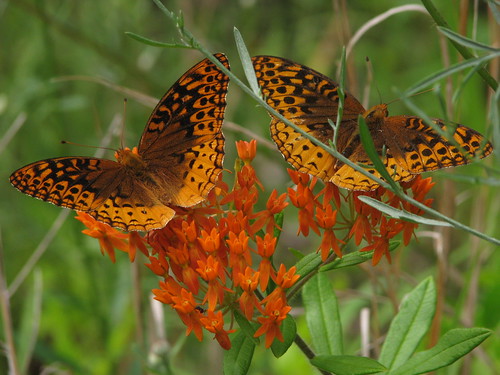You know we love our butterflies here and I just had to share this nifty Butterfly Home from Pam at Gingerbread Snowflakes. You can spend more money on a fancy "store-bought" home, but why?
Have you ever checked out Dollar Store Crafts? It's a super cool site for the thrifty and creative. Go look- it's neat.
 |
| Photo by Shihmei Barger via Flickr Creative Commons |
A great plant for attracting butterflies to your garden is Asclepias tuberosa, or Butterfly Weed. A member of the milkweed family, you've probably seen it in rock gardens or growing wild out in fields. It produces huge amounts of nectar, which makes it so attractive to a variety of butterflies, including the Monarch. Common milkweed, however, is your best bet if you specifically want to attract Monarchs. Butterfly Weed blooms from June through September.
 |
| Photo by milesizz via Flickr Creative Commons |
You may be tempted to sneak out into someone's field and dig up a plant for your own garden. These are pretty prolific plants and surely no one would miss one little plant, right? The whole trespassing/stealing conversation aside, Butterfly Weed puts down a deep tap-root and does not transplant very well. Ask the property owner if you may collect seeds in the fall from the pods or find a seed company that sells them. An Internet search will turn up something for you.
 |
| Photo by Richard Bonnet via Flickr Creative Commons |
August is a good time to get some Butterfly Weed of your own started from seed. Direct sow the seeds into your flower bed or planting area. This will get them started this year and allows for the cold period the seeds need. You will get some flowers in the spring and even more the following year. If you start your seeds in the spring, you will most likely not get flowers the first year but the plant itself will get nice and full and bushy. The second year will give you a good batch of flowers and lots of butterflies. These two sites have some good information on the plant:
Wildflower.org from the University of Texas at Austin (Gig 'em Aggies)
Butterfly Gardening and Conservation
 |
| Photo by Danny Barron via Flickr Creative Commons |
There are many herbal, Native American, and folk uses for this plant, some legitimate, some not. Keep in mind that as a milkweed, all parts of this plant are toxic.
A word or two about handling butterflies ...
A word or two about handling butterflies ...
 |
| Photo by Bruce Tanner via Flickr Creative Commons |
It's kind of a myth that touching a butterfly will rub off the wing scales and cause it to be unable to fly. Yes, touching the wings will rub off some of the scales. However, butterflies shed wing scales across their lifespan just doing regular butterfly things like nectaring, mating, puddling, and brushing against plants. Butterflies cannot replace lost scales, which is why you see clear patches on the wings of older butterflies. Rough handling, however, can break the wings or damage internal organs.
I scoop butterflies off of our screened-in porch almost every day during the summer to keep them from thrashing themselves silly against the screen. Just cup them gently with both hands, holding them securely enough to keep them from fluttering wildly. When you open your hands they will generally fly away quickly but sometimes they will just sit there and you get a little surprise of being able to visit for awhile until they are ready to go. I would probably discourage most folks from handling butterflies. Just because ...
Butterflies will sometimes land on you either not realizing you are any different from any other handy perch or they may be attracted to the salts and minerals on your skin, generally from sweat.
So that about does it for today. Thanks for landing here today and hey- go out and enjoy the butterflies.





No comments:
Post a Comment